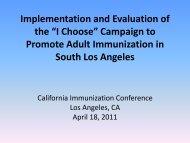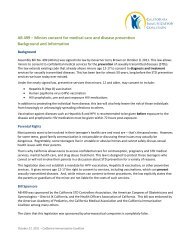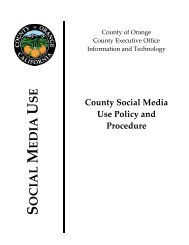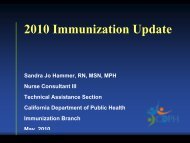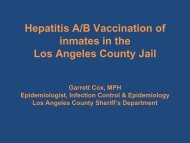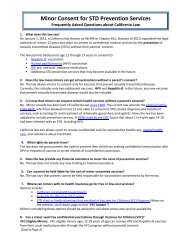Kathleen Harriman - California Immunization Coalition
Kathleen Harriman - California Immunization Coalition
Kathleen Harriman - California Immunization Coalition
You also want an ePaper? Increase the reach of your titles
YUMPU automatically turns print PDFs into web optimized ePapers that Google loves.
Healthcare Personnel<br />
<strong>Immunization</strong><br />
Recommendations<br />
<strong>Kathleen</strong> <strong>Harriman</strong>, PhD, MPH, RN<br />
<strong>California</strong> Department of Public Health<br />
<strong>Immunization</strong> Branch<br />
Vaccine Preventable Disease Epidemiology Section<br />
kathleen.harriman@cdph.ca.gov<br />
510-620-3767
Where do U.S. immunization<br />
recommendations come from?<br />
Advisory Committee on <strong>Immunization</strong> Practices (ACIP)<br />
• 15 experts selected by the U.S. Secretary of HHS to<br />
provide advice and guidance to CDC on the control of<br />
vaccine preventable diseases; the only entity in the<br />
federal government that makes such recommendations<br />
• Develops written recommendations for routine<br />
administration of vaccines to children and adults in the<br />
civilian population; recommendations include age for<br />
vaccine administration, number of doses/dosing intervals,<br />
and precautions and contraindications
ACIP Recommended <strong>Immunization</strong>s<br />
for U.S. Healthcare Personnel (HCP)<br />
• Hepatitis B vaccine<br />
• MMR (measles, mumps, and rubella) vaccine<br />
• Varicella vaccine<br />
• Influenza vaccine<br />
• Tdap (tetanus, diphtheria, and acelluar<br />
pertussis) vaccine<br />
• Meningococcal vaccine*<br />
* Give 1 dose to microbiologists who are routinely<br />
exposed to isolates of N. meningitidis<br />
http://www.cdc.gov/vaccines/spec-grps/hcw.htm
CDC Definition of Healthcare<br />
Personnel<br />
• All paid and unpaid persons working in healthcare settings<br />
who have the potential for exposure to patients with<br />
influenza, infectious materials, including body substances,<br />
contaminated medical supplies and equipment, or<br />
contaminated environmental surfaces.<br />
• HCP might include (but are not limited to):<br />
• physicians, nurses, nursing assistants, therapists, technicians,<br />
emergency medical service personnel, dental personnel, pharmacists,<br />
laboratory personnel, autopsy personnel, students and trainees,<br />
contractual staff not employed by the health-care facility, and persons<br />
(e.g., clerical, dietary, housekeeping, maintenance, and volunteers)<br />
not directly involved in patient care but potentially exposed to<br />
infectious agents that can be transmitted to and from HCP
2010 ACIP adult immunization recommendations<br />
http://www.cdc.gov/vaccines/recs/schedules/downloads/adult/2010/adult-schedule.pdf
Required <strong>Immunization</strong>s for<br />
<strong>California</strong> Healthcare Personnel<br />
• There are no federal or <strong>California</strong><br />
state requirements for vaccination<br />
• Facilities may require vaccinations as<br />
a condition of employment<br />
State immunization laws for HCP and patients<br />
http://www2a.cdc.gov/nip/StateVaccApp/statevaccsApp/default.asp
Vaccine that is required to be offered* per the<br />
Cal/OSHA Bloodborne Pathogen standard<br />
• Hepatitis B vaccine – three doses<br />
* To all employees who are exposed to blood or other<br />
potentially infectious materials as part of their job duties.<br />
If vaccine is declined, a declination form must be signed.
Vaccines that are required to be offered* per the<br />
Cal/OSHA Aerosol Transmissible Disease (ATD)<br />
standard as of September 1, 2010<br />
Vaccine<br />
• Influenza†<br />
• Measles<br />
• Mumps<br />
• Rubella<br />
• Tetanus, diphtheria, and<br />
acellular pertussis (Tdap)<br />
• Varicella-zoster (VZV)<br />
Schedule<br />
• One dose annually<br />
• Two doses<br />
• Two doses<br />
• One dose<br />
• One dose, booster<br />
as recommended<br />
• Two doses<br />
* To all susceptible employees who might be exposed.<br />
If vaccine is declined, a declination form must be signed.<br />
† Seasonal vaccine was required to be offered in 2009.
Diseases covered by the ATD<br />
standard<br />
• Applies to diseases classified by CDC’s Healthcare<br />
Infection Control Advisory Committee (HICPAC)<br />
as having either droplet or airborne transmission*<br />
• Novel or unknown pathogens considered airborne<br />
• Only “reportable diseases” under Title 17†<br />
require exposure investigation<br />
* 2007 Guideline for Isolation Precautions:<br />
Preventing Transmission of Infectious Agents in Healthcare Settings<br />
http://www.cdc.gov/hicpac/2007IP/2007isolationPrecautions.html<br />
† http://www.cdph.ca.gov/HealthInfo/Documents/Reportable_Diseases_Conditions.pdf
Work settings covered by the<br />
ATD standard<br />
• Applies in health care settings, such as:<br />
• Hospitals<br />
• Long-term care<br />
• Primary care<br />
• Emergency medical<br />
• Applies in other high risk environments<br />
• Corrections<br />
• Homeless shelters<br />
• Drug treatment programs<br />
• First receivers<br />
• Laboratories
Which employees are covered?<br />
• Exposure from work activity or working conditions<br />
that is reasonably anticipated to create an<br />
elevated risk of contracting any disease caused by<br />
aerosol-transmissible pathogens if protective<br />
measures are not in place<br />
• “Elevated” risk means higher than what is<br />
considered ordinary for employees having direct<br />
contact with the general public outside of the<br />
facilities, service categories, and operations listed<br />
in the standard<br />
http://www.dir.ca.gov/Title8/5199.html
Occupational Exposure<br />
• In each included work setting covered by the<br />
standard, it is presumed that some employees<br />
have occupational exposure; for a particular<br />
employee it depends on tasks, activities, and the<br />
environment<br />
• Includes having contact with, or being within<br />
exposure range of cases or suspected cases of<br />
aerosol-transmissible diseases<br />
• Employers must identify employees with<br />
occupational exposure in order to take protective<br />
measures
Examples of Possible<br />
Occupational Exposures<br />
• Intake or triage of<br />
patients<br />
• Providing care to influenza<br />
patients<br />
• Testing people for TB<br />
• Taking a throat swab for<br />
strep<br />
• Cleaning patient rooms<br />
• Transporting patients
Influenza Vaccine
Annual HCP Influenza<br />
Vaccination<br />
• Offer to all eligible HCP at no cost<br />
• Educate HCP about vaccination benefits and<br />
consequences of influenza illness for themselves<br />
and their patients<br />
• Obtain signed declination forms<br />
• Monitor coverage including ward, unit, and<br />
specialty-specific coverage rates<br />
• Years of efforts to increase uptake have not<br />
increased rates significantly in most facilities<br />
- mandate vaccination??
Barriers to HCP Vaccination<br />
• Fear of vaccine side effects (particularly<br />
influenza-like illness symptoms)<br />
• Perceived ineffectiveness of the vaccine<br />
• Medical contraindication (not always valid)<br />
• Perceived low likelihood of contracting influenza<br />
• Fear of needles<br />
• Insufficient time or inconvenience
Mandatory Vaccination<br />
• Seattle: Virginia Mason – first U.S. hospital to mandate influenza<br />
vaccination or mask wearing during influenza season<br />
• St. Louis: Barnes-Jewish – first U.S. hospital to mandate influenza<br />
vaccination and terminate noncompliant employees<br />
• New York: 2009 emergency regulation (subsequently withdrawn)<br />
required seasonal and pandemic H1N1 vaccination of personnel in<br />
hospitals, home care, hospice, and diagnostic/treatment facilities<br />
• http://www.health.state.ny.us/diseases/communicable/influenza/seasonal/providers/<br />
2009-08-26_health_care_worker_mandatory_influenza_immunization.htm<br />
• <strong>California</strong>: hospitals must offer vaccine at no cost to employees<br />
• Vaccination or written declination required per SB 739<br />
• Public reporting of vaccination rates via CDC’s National Healthcare Safety<br />
Network (NHSN) required<br />
• Some hospitals mandated vaccination or mask wearing in 2009
National Organization Influenza<br />
Vaccination Recommendations<br />
• IDSA 2009<br />
• Mandatory vaccination or mask wearing<br />
• APIC 2008<br />
• Supports requiring influenza immunization for all HCP who have<br />
direct patient contact<br />
• Also recommends that healthcare facilities obtain informed<br />
statements acknowledging the risk to patients from employees<br />
who decline the vaccine for other than medical reasons<br />
• ACIP 2007<br />
• Level of vaccination coverage among HCP to be one measure of a<br />
patient safety quality program<br />
• Implement policies to encourage HCP vaccination (e.g., obtaining<br />
signed statements from HCP who decline influenza vaccination)<br />
• SHEA 2005<br />
• Vaccination or declination<br />
• Most unions oppose mandatory vaccination
Joint Commission<br />
Standard IC.02.04.01: The organization offers<br />
vaccination against influenza to licensed independent<br />
practitioners and staff.<br />
1. The hospital establishes an annual influenza vaccination<br />
program that is offered to licensed independent practitioners<br />
and staff.<br />
2. The hospital educates licensed independent practitioners and<br />
staff about, at a minimum, the influenza vaccine; non-vaccine<br />
control and prevention measures; and the diagnosis,<br />
transmission, and impact of influenza.<br />
3. The hospital provides influenza vaccination at sites accessible<br />
to licensed independent practitioners and staff.<br />
4. The hospital annually evaluates vaccination rates and the<br />
reasons given for declining the influenza vaccination.<br />
5. The hospital takes steps to increase influenza vaccination rates.
Hepatitis B
Hepatitis B Vaccination<br />
• Any person who performs tasks involving<br />
contact with blood, blood contaminated body<br />
fluids, other body fluids, or sharps should be<br />
vaccinated against hepatitis B<br />
• Highly immunogenic – seroconversion ~95%<br />
• Incidence among HCP since mid-1990s is<br />
lower than general population due to<br />
vaccination and standard precautions<br />
Updated U.S. P.H.S. Guidelines for the Management of Occupational Exposures to HBV, HCV, and<br />
HIV and Recommendations for Post-exposure Prophylaxis. MMWR 50 (RR11) - 6/29/01<br />
http://www.cdc.gov/mmwr/preview/mmwrhtml/rr5011a1.htm
Estimated Number of Acute HBV Infections Due to<br />
Occupational Exposures, United States, 1983-2002<br />
Estimated # of Infections<br />
12,000<br />
10,000<br />
8,000<br />
6,000<br />
4,000<br />
2,000<br />
0<br />
Vaccine<br />
Recommended<br />
for HCP<br />
OSHA<br />
Requirements<br />
1982 1984 1986 1988 1990 1992 1994 1996 1998 2000 2002<br />
Year
Hepatitis B<br />
• HCP with potential for exposure to blood or body<br />
fluids should be vaccinated for hepatitis B with 3-dose<br />
vaccine series<br />
• Test HCP 1-2 months after last dose of vaccine series<br />
to determine if immune<br />
• Persons with written documentation of complete<br />
vaccine series but without postvaccination testing do<br />
not need immunity testing unless they have an<br />
exposure to blood or body fluids<br />
• Periodic titers or booster doses of vaccine not<br />
recommended - protection is long lasting
Measles
Measles Transmission<br />
• Measles is transmitted via the airborne route and is<br />
thought to be the most infectious communicable disease<br />
• Indigenous transmission of measles in the U.S. was<br />
declared eliminated in 2000; concern over recent imported<br />
cases<br />
• Measles transmission has been documented in physician<br />
offices, emergency rooms, and hospital wards and HCP<br />
have been infected in recent outbreaks<br />
• Good documentation and high levels of immunity minimize<br />
the amount of work that needs to be done in the event of<br />
an exposure<br />
• Record review for hundreds to thousands staff<br />
• Serologic testing and vaccination
Presumptive Evidence of<br />
Immunity to Measles<br />
• Documented administration of two doses of live<br />
measles virus vaccine on or after the first<br />
birthday and at least 28 days apart; or<br />
• Laboratory evidence of immunity or laboratory<br />
confirmation of disease; or<br />
• Birth before 1957*<br />
Documentation of physician-diagnosed measles<br />
is no longer acceptable evidence of immunity<br />
* Since ~ 5% of people born before 1957 are susceptible to measles, CDPH<br />
recommends that immunity be assessed if such HCP are exposed to measles;<br />
during an outbreak, 2 doses of MMR are recommended for unvaccinated HCP<br />
without evidence of immunity
MMR Vaccination for HCP Born<br />
Before 1957<br />
• HCP born before 1957 are generally presumed to be<br />
immune to measles, mumps, and rubella, but not all are<br />
• Healthcare facilities should consider recommending 2<br />
doses of MMR vaccine routinely for unvaccinated HCP<br />
born before 1957 who do not have laboratory evidence of<br />
disease or immunity to measles, mumps, and/or rubella<br />
• For these same HCP who do not have evidence of<br />
immunity, healthcare facilities should recommend 2 doses<br />
of MMR vaccine during an outbreak of measles or mumps<br />
and 1 dose during an outbreak of rubella
Mumps
Presumptive Evidence of<br />
Immunity to Mumps<br />
• Documented administration of two doses of live<br />
mumps virus vaccine on or after the first<br />
birthday and at least 28 days apart; or<br />
• Laboratory evidence of immunity or laboratory<br />
confirmation of disease; or<br />
• Born before 1957*<br />
Documentation of physician-diagnosed mumps<br />
is no longer acceptable evidence of immunity<br />
* During an outbreak, 2 doses of MMR are recommended for<br />
unvaccinated<br />
HCP without evidence of immunity
Nosocomial Transmission of Measles<br />
and Mumps in Healthcare Facilities<br />
• During 2001-8, 27 reported measles cases were<br />
transmitted in healthcare settings, accounting for 5% of<br />
all reported U.S. measles cases (CDC, unpublished data)<br />
• In 2008, 11% of cases; considerable economic cost and public<br />
health effort to contain (~$100,000 to $400,000)<br />
• In Arizona in 2008, the largest nosocomial U.S. measles<br />
outbreak (14 cases) occurred in 20 years<br />
• At 3 hospitals, almost 8000 HCP were exposed; 25% had no<br />
documentation of immunity so were serologically tested<br />
• 30% were born before 1957 ( 5% susceptible)<br />
• 70% born >1957 (11% susceptible)<br />
• In Tennessee in 1986-87, nosocomial transmission of<br />
mumps occurred in 2 hospital ERs infecting 6 HCP and in 2<br />
long-term care facilities infecting 9 patients
Rubella
Presumptive Evidence of<br />
Immunity to Rubella<br />
• Documented administration of one dose of live<br />
rubella virus vaccine; or<br />
• Laboratory evidence of immunity* or laboratory<br />
confirmation of disease; or<br />
• Born before 1957** (except premenopausal<br />
women who could become pregnant)<br />
* HCP who can provide documentation of serological evidence of rubella<br />
immunity (e.g., via past prenatal testing) do not need to be retested and<br />
should be considered immune<br />
** During an outbreak, 1 dose of MMR recommended for unvaccinated<br />
HCP without evidence of immunity
Varicella
Varicella Among HCP<br />
• Nosocomial transmission of is varicella is wellrecognized<br />
• Sources<br />
• Patients, hospital staff, and visitors with varicella or<br />
herpes zoster<br />
• Airborne transmission of varicella has been<br />
demonstrated<br />
• Varicella has occurred in susceptible persons who<br />
had no direct contact with index case-patient<br />
• Virus detected in air
Evidence of Immunity to<br />
Varicella in HCP<br />
• Documentation of two doses of vaccine given<br />
at least 28 days apart; or<br />
• Laboratory evidence of immunity or laboratory<br />
confirmation of disease; or<br />
• Diagnosis or verification of history of varicella<br />
disease by a healthcare provider; or<br />
• Diagnosis or verification of a history of herpes<br />
zoster (shingles) by a healthcare provider
2007 ACIP Recommendations<br />
• Serologic screening before vaccination<br />
• Testing unvaccinated HCP with a negative or uncertain<br />
history of varicella is likely to be cost-effective; or<br />
• Test all HCP, because small proportion with positive<br />
history of disease might be susceptible<br />
• Routine testing after 2 doses of vaccine is not<br />
recommended<br />
• Available commercial assays not sensitive enough<br />
• In sensitive tests, 99% of adults develop antibodies<br />
after 2 nd dose<br />
http://www.cdc.gov/mmwr/pdf/rr/rr5604.pdf
Pertussis
Pertussis in the United States<br />
• Least well controlled vaccine preventable disease<br />
• It is cyclical; 2005 was the last peak year and increases<br />
in the first quarter of 2010 are concerning<br />
• Most severe disease occurs among infants
Costs of Controlling Pertussis<br />
in Healthcare Facilities<br />
• $74,870-$174,327 per outbreak<br />
• $42,000-$98,000/year for pertussis exposures<br />
• Costs include identifying contacts among HCP and<br />
patients, providing postexposure prophylaxis for<br />
asymptomatic close contacts, and evaluating, treating,<br />
and placing symptomatic HCP on administrative leave<br />
until they have received effective treatment<br />
MMWR December 15, 2006;55(RR17)<br />
http://www.cdc.gov/mmwr/PDF/rr/rr5517.pdf
Tdap Vaccine and HCP<br />
• In 2005, a vaccine containing tetanus and diphtheria<br />
toxoids and acellular pertussis vaccine (Tdap) was licensed<br />
in the U.S. for persons aged 11-64 years (ADACEL ® )<br />
• In 2006, ACIP recommended that HCP in hospitals or<br />
ambulatory care settings with direct patient contact<br />
receive Tdap as soon as feasible if they had not previously<br />
received it<br />
• Although recommended for all HCP with patient contact,<br />
HCP who have direct contact with infants 12 months of<br />
age and younger should be strongly encouraged to be<br />
vaccinated<br />
http://www.cdc.gov/mmwr/PDF/rr/rr5517.pdf
Implementing Hospital Tdap<br />
Program<br />
• Infrastructure for vaccination exists in most<br />
hospitals<br />
• New personnel screened and vaccinated on<br />
employment<br />
• Can be given at same time as influenza vaccine<br />
• A booster dose is likely to be recommended in the<br />
future<br />
• In addition, birth hospitals are encouraged<br />
to promote postpartum Tdap vaccination<br />
of new mothers to protect young infants
Most Recent ACIP<br />
Recommendations<br />
Healthcare workers, 1997 (update in 2010?)<br />
http://www.cdc.gov/mmwr/preview/mmwrhtml/00050577.htm<br />
Hepatitis B, 2006<br />
http://www.cdc.gov/mmwr/PDF/rr/rr5516.pdf<br />
Influenza, 2009<br />
http://www.cdc.gov/mmwr/preview/mmwrhtml/rr58e0724a1.htm<br />
Influenza healthcare workers, 2006<br />
http://www.cdc.gov/mmwr/preview/mmwrhtml/rr5502a1.htm<br />
Diphtheria, tetanus, pertussis, 2006<br />
http://www.cdc.gov/mmwr/preview/mmwrhtml/rr5517a1.htm<br />
Measles, mumps, rubella, 1998 and 2009 update<br />
http://www.cdc.gov/mmwr/preview/mmwrhtml/00053391.htm<br />
http://www.cdc.gov/vaccines/recs/provisional/downloads/mmr-evidence-immunity-Aug2009-<br />
508.pdf<br />
Mumps, 2006<br />
http://www.cdc.gov/mmwr/preview/mmwrhtml/mm5522a4.htm<br />
Varicella, 2007<br />
http://www.cdc.gov/mmwr/pdf/rr/rr5604.pdf







